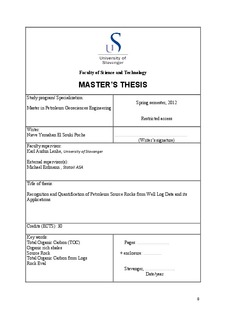| dc.contributor.author | El Souki, Nieve | |
| dc.date.accessioned | 2014-02-06T09:59:38Z | |
| dc.date.issued | 2012-06 | |
| dc.identifier.uri | http://hdl.handle.net/11250/183664 | |
| dc.description | Master's thesis in Petroleum geosciences engineering | no_NO |
| dc.description.abstract | Petroleum source rocks constitute one of the main elements in petroleum systems. Several methods have been developed to characterize source rocks, mainly using geochemical and petrographical laboratory techniques to determine its effective potential of oil generation. Unfortunately laboratory methods are time consuming, costly and limited to a number of samples that vary in quality. Alternatively, geophysical well logs provide the most continuous record with depth of well data and several authors had demonstrated the effect that organic matter has in well logs.
In this study a log data set from two wells located in the North Sea and Barents Sea were evaluated using different tools and method with the purposed of predict source rocks richness. It was proven that the delta log R technique (Passey et.al., 1990) widely used, is an indirect empirical approximation able to quantify Total Organic Carbon only in the presence of calibration data and homogeneous shale package, otherwise can lead in misleading results. Additionally, it was found that using this method the best accuracy is achieved in source rocks with TOC in a range between 4 to 10 %. It was observed that the main source of uncertainty using this method corresponded to the arbitrary and subjective definition of baselines values used in the delta log R equation. An improvement was proposed using trend baselines for non-source rocks, instead of constant values with depth which allowed to recognize anomalous intervals (or source rock) making it a more reasonable practice.
Additionally, a new model to predict TOC from well logs was generated using multiple linear regressions and based on Gamma Ray, Resistivity and Transit time readings. This model is able to predict with a simplified procedure the Total Organic Carbon from well logs giving a better approach in heterogeneous intervals than the previous method. It may help to generate new models using statistical tools that allow a directly determination of TOC from logs with a better control of variables and avoiding biased procedures. | no_NO |
| dc.language.iso | eng | no_NO |
| dc.publisher | University of Stavanger, Norway | no_NO |
| dc.relation.ispartofseries | Masteroppgave/UIS-TN-IPT/2011; | |
| dc.subject | petroleumsteknologi | no_NO |
| dc.subject | total organic carbon (TOC) | no_NO |
| dc.subject | geochemistry | no_NO |
| dc.subject | source rock | no_NO |
| dc.subject | total organic carbon from Logs | no_NO |
| dc.subject | petroleumsgeologi | no_NO |
| dc.title | Recognition and quantification of petroleum source rocks from well log data and its applications | no_NO |
| dc.type | Master thesis | no_NO |
| dc.subject.nsi | VDP::Technology: 500::Rock and petroleum disciplines: 510::Petroleum engineering: 512 | no_NO |
| dc.description.embargo | 2017-07-01 | |
